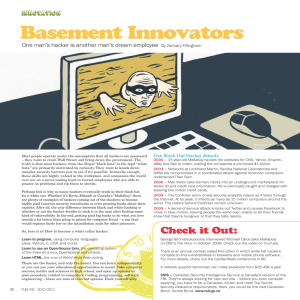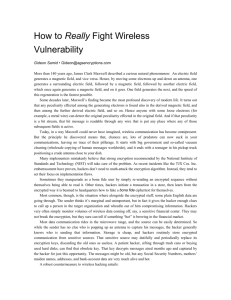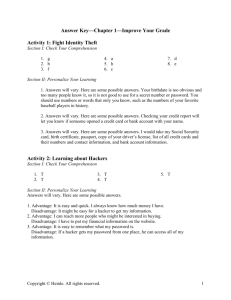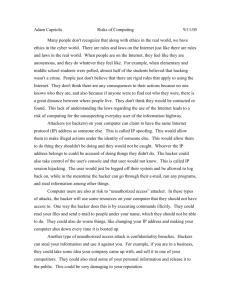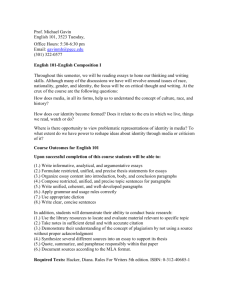Informative Speech
advertisement
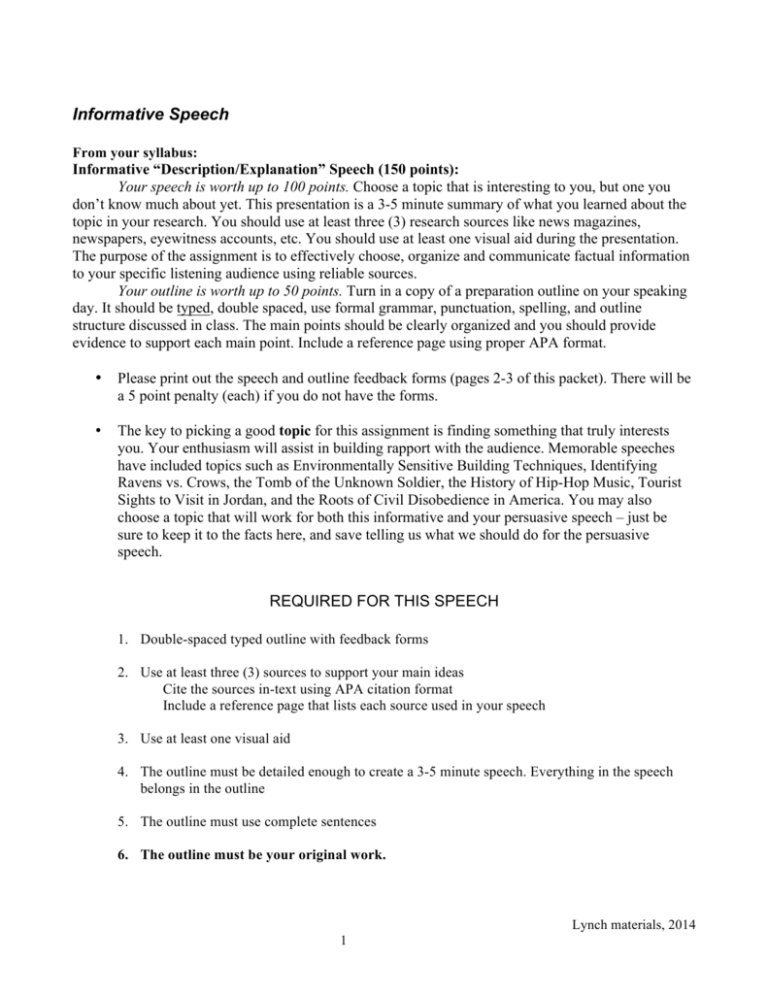
Informative Speech From your syllabus: Informative “Description/Explanation” Speech (150 points): Your speech is worth up to 100 points. Choose a topic that is interesting to you, but one you don’t know much about yet. This presentation is a 3-5 minute summary of what you learned about the topic in your research. You should use at least three (3) research sources like news magazines, newspapers, eyewitness accounts, etc. You should use at least one visual aid during the presentation. The purpose of the assignment is to effectively choose, organize and communicate factual information to your specific listening audience using reliable sources. Your outline is worth up to 50 points. Turn in a copy of a preparation outline on your speaking day. It should be typed, double spaced, use formal grammar, punctuation, spelling, and outline structure discussed in class. The main points should be clearly organized and you should provide evidence to support each main point. Include a reference page using proper APA format. • Please print out the speech and outline feedback forms (pages 2-3 of this packet). There will be a 5 point penalty (each) if you do not have the forms. • The key to picking a good topic for this assignment is finding something that truly interests you. Your enthusiasm will assist in building rapport with the audience. Memorable speeches have included topics such as Environmentally Sensitive Building Techniques, Identifying Ravens vs. Crows, the Tomb of the Unknown Soldier, the History of Hip-Hop Music, Tourist Sights to Visit in Jordan, and the Roots of Civil Disobedience in America. You may also choose a topic that will work for both this informative and your persuasive speech – just be sure to keep it to the facts here, and save telling us what we should do for the persuasive speech. REQUIRED FOR THIS SPEECH 1. Double-spaced typed outline with feedback forms 2. Use at least three (3) sources to support your main ideas Cite the sources in-text using APA citation format Include a reference page that lists each source used in your speech 3. Use at least one visual aid 4. The outline must be detailed enough to create a 3-5 minute speech. Everything in the speech belongs in the outline 5. The outline must use complete sentences 6. The outline must be your original work. Lynch materials, 2014 1 Support Materials Informative Speaking Guide for Planning an Informative Speech (Description & Explanation) I. The Introduction B. Get attention by using one or more of the following choices An illustration or story A startling statement A quotation A rhetorical question A reference to the subject A reference to the occasion (what makes this day unique) C. Motivate audience interest in your subject by alluding to the practical value of the information for your audience. A reason to listen State topic clearly, but build a sense of curiosity D. Establish your right to inform (speaker credibility) by Alluding to any first-hand experience you may have had Alluding to sources of information you have consulted E. Provide orienting material by Previewing main points (signposting) Defining any technical terms that you will be using If necessary supplying any background information that would better enable listeners to understand the information II. The Body A. Choose 3-5 main points of equal weight that directly support your specific purpose. B. Make your information understandable by using an organizational format Chronological or step-by-step order Causal Spatial Topical C. Support your main points with appropriate evidence Factual examples and illustrations Analogies Statistics Testimony Lynch materials, 2014 2 D. Make your information understandable by using visual aids Charts, drawings Objects or models of objects Diagrams, maps E. Make your information interesting By using vivid imagery Concrete language Having it at a level appropriate to your audience Involving something recent, impending, or familiar F. Use clear transitions between main points “Now that I’ve explained ____, let me move on to ____.” III. The Conclusion A. End the speech appropriately by restating your main points B. Tie back to something said in the introduction C. End the speech providing us with a “reason to remember” A quotation A story A comment to arouse interest in further investigation of the topic Lynch materials, 2014 3 Sample Skeleton of Informative Outline Title: __________________________________________________________________ General Purpose: ________________________________________________________ Specific Purpose: ________________________________________________________ Thesis Statement: ________________________________________________________ I. Introduction A. Attention Getter ___________________________________________________ B. Reason to Listen ___________________________________________________ C. Speaker Credibility _________________________________________________ D. Preview of Main Points ______________________________________________ 1. Main Point _____________________________________________________ 2. Main Point _____________________________________________________ 3. Main Point _____________________________________________________ II. Body A. (Main Point #1) ____________________________________________________ 1. ______________________________________________________________ 2. ______________________________________________________________ a. ___________________________________________________________ b. ___________________________________________________________ Transition: ______________________________________________________________ B. (Main Point #2) ____________________________________________________ 1. ______________________________________________________________ 2. ______________________________________________________________ 3. ______________________________________________________________ Transition: ______________________________________________________________ C. (Main Point #3) ____________________________________________________ 1. ______________________________________________________________ a. ___________________________________________________________ b. ___________________________________________________________ 2. ______________________________________________________________ a. ___________________________________________________________ Lynch materials, 2014 4 b. ___________________________________________________________ c. ___________________________________________________________ 3. ______________________________________________________________ 4. ______________________________________________________________ III. Conclusion A. Restate Topic and Main Points ________________________________________ 1. Main Point _____________________________________________________ 2. Main Point _____________________________________________________ 3. Main Point _____________________________________________________ B. Tie Back to Introduction _____________________________________________ C. Reason to Remember _______________________________________________ Lynch materials, 2014 5 Informative Sample Outline (Note: this outline was written in 1999 and shows how important it is to use current sources for your information. Some of the claims may no longer be accurate.) Pirates on the Information Super Highway Joe Computer GEO 102: Lynch October 25, 1999 Lynch materials, 2014 6 General Purpose: To inform. Specific Purpose: To inform the audience about internet hacking. Central Idea: To inform my audience about some tools hackers use, how hackers get access to computers, and what hackers do once they have access to computers. PIRATES ON THE INFORMATION SUPER HIGHWAY I. Introduction A. (Attention Getter) (Extended Example) A woman cruises the internet doing a little online shopping. She visits her bank account online to review her balance and then logs off. Little does she know, her son Johnny had recently and unknowingly downloaded a funny program that showed dancing bears on his computer screen. What wasn’t so funny was that a hacker had attached a small file onto that funny program which, when downloaded, could spy on Johnny’s computer. A few weeks later the woman received a bank statement showing hundreds of dollars worth of online purchases. She has just become a victim of computer fraud (Regan, 1999). B. (Reason to Listen/Topic) This is not by any means a new phenomenon, it has just become easier for hackers to find targets as people utilize and become more and more dependant on the internet. C. (Speaker Credibility) I have received various viruses through emailed programs in the past. Though I have never been the victim of online theft, I have been extensively researching computer crime cases for the past couple of weeks. D. (Thesis and Preview) Tonight I will describe to you one method in which a hacker can rob you blind. 1. First I will explain some of the tools hackers use. 2. Second, I will show you all how a hacker gets into a victim’s computer. Lynch materials, 2014 7 3. And third, I will unveil what a hacker could do once inside your computer. II. Body A. First let me describe to you the tools a hacker has available to infiltrate your computer. 1. One of the most popular and powerful of the hacker tools is surprisingly easy to obtain. The program is called “Back Orifice.” a. This program gives the hacker the ability to virtually hijack your computer and do anything with it that you would be able to do. b. Not only can the hacker get to all your files, the hacker can see every keystroke you type in (Warren, 1999). 2. (Expert Testimony) A Microsoft security expert said, “Back Orifice’s worst attribute is that it attacks the users not the technology” (as cited in McKay, 1999, p. 56). 3. Still other programs trick users into entering passwords to exit an application, such as internet email (Wells, 1999). Transition: Well, we have seen the tools a hacker has at his/her disposal, now let’s see how they get into your computer. B. Hackers may use a tactic called social engineering to enter your computer, in other words they try to trick you into letting them inside. When this id done, the program is called a Trojan Horse (Harter, 1999). 1. Probably the most popular way of getting the hacker’s program into your computer is through email attachments (McKay, 1999). a. You may receive a friendly email offering you a screen saver, a game update, or a funny program that shows dancing bears. 2. A second popular way for hackers to get into your computer is through infected programs such as games and internet tools that are downloaded off the internet from unreliable web sites (McKay, 1999). Transition: So we have seen how hackers may use a Trojan Horse to trick you into letting them into Lynch materials, 2014 8 your computer. Now I will explain what a hacker could do once inside. C. The tools the hackers are equipped with give them the ability to do malicious or fraudulent acts, depending on your hacker. 1. A mischievous hacker would probably do little harm. a. They may erase some or all of your computer files (Carlton, 1999). b. They might install new malicious programs on your computer (Carlton, 1999). c. The hacker could play hoaxes on you that display obscene messages on your screen (Carlton, 1999). d. Or use your computer as a jump off point to propagate their Trojan Horse so it cannot be traced back to them (Warren, 1999). 2. A more enterprising hacker would probably go for more sensitive information. a. This kind of hacker would lay in wait for you to enter user names, passwords, and credit-card numbers by capturing every keystroke you make. This can be very dangerous if you do any kind of online banking (Warren, 1999). b. The hacker may now make online purchases or do anything to your bank account you could do online. III. Conclusion A. So tonight I have shared with you all how a hacker steals you money. I first showed you how the hacker has to choose the right tools, then how the hacker tricks you into letting him/her into your computer, and finally what the hacker does once inside your computer. B. Unknown to little Johnny, those little dancing bears would cost his mother a lot of money (Regan, 1999). C. I hope the next time you “surf the net” you keep an eye out for the dangers that lurk on the internet. Lynch materials, 2014 9 References Carlton, G. (1999, April 23). Chasing cyberspace crooks: criminals adopt high tech versions of age-old crimes. Madison Capital Times, p. 1C. Harter, B (1999, April 15). Internet biking. Wireless Review, p. 14-21. McKay, N. (1999, July 30). Wired on Friday – from Las Vegas. Irish Times, p. 56. Regan, T. (1999, October 7). Putting the dancing pigs in their cyber-pen. Christian Science Monitor, p. 18. Warren, D (1999). Back Orifice Information Center. Available: www.ozemail.com.au/~dwarren/backorifice/questandansw.html. Accessed October 22, 1999. Wells, M. (1999, September 8). Second security breach as Microsoft fails to plug gap in e-mail. The Scotsman, p. 22. Lynch materials, 2014 10

